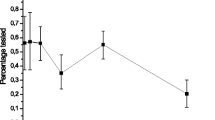Abstract
A venue-based HIV prevention study which included Voluntary Counseling and Testing (VCT) was conducted in three diverse areas of Kenya—Malindi, Nanyuki and Rachounyo. Aims of the study were to: (1) assess the acceptability of VCT for the general population, men who have sex with men (MSM), and injecting drug users (IDUs) within the context of a venue-based approach; (2) determine if there were differences between those agreeing and not agreeing to testing; and (3) study factors associated with being HIV positive. Approximately 98% of IDUs and 97% of MSM agreed to VCT, providing evidence that populations with little access to services and whose behaviors are stigmatized and often considered illegal in their countries can be reached with needed HIV prevention services. Acceptability of VCT in the general population ranged from 60% in Malindi to 48% in Nanyuki. There were a few significant differences between those accepting and declining testing. Notably in Rachuonyo and Malindi those reporting multiple partners were more likely to accept testing. There was also evidence that riskier sexual behavior was associated with being HIV positive for both men in Rachounyo and women in Malindi. Overall HIV prevalence was higher among the individuals in this study compared to individuals sampled in the 2008–2009 Kenya Demographic and Health Survey, indicating the method is an appropriate means to reach the highest risk individuals including stigmatized populations.



Similar content being viewed by others
References
Kenya National Bureau of Statistics and ICF Macro. Kenya Demographic and Health Survey 2008–09. Calverton, Maryland: KNBS and ICF Macro; 2010.
Garcia-Calleja JM, Gouws E, Ghys PD. National population based HIV prevalence surveys in sub-Saharan Africa: results and implications for HIV and AIDS estimates. Sex Transm Infect. 2006;82:III64–70.
Kenya National AIDS Control Council et al. HIV prevention response and modes of transmission. Analysis, Final Report, March 2009.
Weir SS, Tate JE, Zhusupov B, Boerma JT. Where the action is: monitoring local trends in sexual behaviour. Sex Transm Infect. 2004;80:63–8.
Tate J, Singh K, Ndubani P, Kamwanga J, Buckner B. Measurement of HIV prevention indicators: a comparison of the PLACE method and a household survey in Zambia. AIDS Behav. 2010;14(1):209–17.
USAID/Kenya. HIV/AIDS Health Profile; 2010.
Human Rights Watch. Kenya: Halt anti-gay campaign. Human Rights Watch [press release] 2010; Available from http://www.hrw.org/en/news/2010/02/17/kenya-halt-anti-gay-campaign. Accessed 1 Feb 2011.
Beyrer C, Wirtz AL, Baral S, Peryskina A, Sifakis F. Epidemiologic links between drug use and HIV epidemics: an international perspective. J Acquir Immune Defic Syndr. 2009;55:S10–6.
Adam PCG, de Wit JBE, Toskin I, Mathers BM, Nashkhoev M, Zablotska I, et al. Estimating levels of HIV testing, HIV prevention coverage, HIV knowledge, and condom use among men who have sex with men (MSM) in low-income and middle-income countries. J Acquir Immune Defic Syndr. 2009;52:S143–51.
Global HIV Prevention Working Group. Bringing HIV prevention to scale: an urgent global priority. Seattle/Menlo Park: Bill & Melinda Gates Foundation/Henry J. Kaiser Family Foundation; 2007.
Sanders EJ, Graham SM, Okuku HS, van der Elst EM, Muhaari A, Davies A, et al. HIV-1 infection in high risk men who have sex with men in Mombasa, Kenya. AIDS. 2007;21(18):2513–20.
Wade AS, Kane CT, Diallo PAN, Diop AK, Gueye K, Mboup S, et al. HIV infection and sexually transmitted infections among men who have sex with men in Senegal. AIDS. 2005;19(18):2133–40.
Baral S, Trapence G, Motimedi F, Umar E, Iipinge S, Dausab F, et al. HIV prevalence, risks for HIV infection, and human rights among men who have sex with men (MSM) in Malawi, Namibia, and Botswana. PLoS One. 2009;4(3):e4997.
Merrigan M, Azeez A, Afolabi B, Chabikuli ON, Onyekwena O, Eluwa G, et al. HIV prevalence and risk behaviours among men having sex with men in Nigeria. Sex Transm Infect. 2010;87:65–70.
Dahoma M, Johnston L, Holman A, Miller L, Mussa M, Othman A, et al. HIV and related risk behavior among men who have sex with men in Zanzibar, Tanzania: results of a behavioral surveillance survey. AIDS Behav. 2011;15(1):186–92.
United Nations Office on Drug and Crime. Consensus statement of the reference group to the United Nations on HIV and Injection Drug Use. 2010. Vienna.
Needle RH, Kroegger K, Belani H, Hegle J. Substance abuse and HIV in sub-Saharan Africa: introduction to the special issue. Afr J Drug Alcol Stud. 2006;5:83–95.
Odek-Ogunde M, Okoth FA, Lore W, Owiti FR. Seroprevalence of HIV, HBC and HCV in injecting drug users in Nairobi, Kenya: World Health Organization drug injecting study phase II findings. In: 15th international AIDS conference, Bangkok. 2004.
Deveau C, Levine B, Beckerleg S. Heroin use in Kenya and findings from a community based outreach programme to reduce the spread of HIV/AIDS. Afr J Drug Stud. 2006;5:95–107.
Singh K, Sambisa W, Munyati S, Chandiwana B, Chingono A, Monash R, et al. Targeting HIV interventions for adolescent girls and young women in southern Africa: use of the PLACE methodology in Hwange District, Zimbabwe. AIDS Behav. 2010;14(1):200–8.
Smith AD, Tapsoba P, Peshu N, Sanders EJ, Jaffe HW. Men who have sex with men and HIV/AIDS in sub-Saharan Africa. Lancet. 2009;374(9687):416–22.
Speizer IS, Beauvais H, Gomez AM, Outlaw TF, Roussel B. Using multiple sampling approaches to measure sexual risk-taking among young people in Haiti: programmatic implications. Stud Fam Plan. 2009;40(4):277–88.
Acknowledgments
Funding for this project was provided by the United States Agency for International Development through the APHIA II Evaluation. The authors wish to thank all interviewers and study participants as well as Erica Haney for her assistance with the literature review.
Author information
Authors and Affiliations
Corresponding author
Rights and permissions
About this article
Cite this article
Singh, K., Brodish, P., Mbai, F. et al. A Venue-Based Approach to Reaching MSM, IDUs and the General Population with VCT: A Three Study Site in Kenya. AIDS Behav 16, 818–828 (2012). https://doi.org/10.1007/s10461-011-0103-z
Published:
Issue Date:
DOI: https://doi.org/10.1007/s10461-011-0103-z



